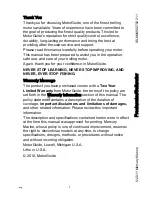
15
FUEL
Fuel
The fuel used for the propulsion of internal
combustion engines is highly flammable and, in
certain cases can become explosive.
Refuelling and maintenance operations must be
done in a well-ventilated area and with the engine
stopped.
Do not smoke while refuelling, keep away from
sparks, flames, or other sources of ignition, which
could cause fire or explosion.
Do not spill gasoline. If gasoline spills, wipe it
immediately with dry rags, before starting the motor .
Do not overfill the fuel tank, because gasoline
expands with the heat and the sun radiation.
Tighten the filler cap securely after refuelling.
Do not let gasoline get into your eyes or onto your
skin. Avoid swallowing gasoline or inhaling its
vapour. Do not pour fuel off using a pipe.
KEEP OUT OF CHILDREN REACH
Preparation of the fuel
Use only petrol with a octane number higher than 95
N.O. Research and that they not contain alcohol,
(see the detailed list)
Fuel tank clamping and pipes connection
Put the fuel tank horizontally in the hull, anchored to the
bottom, in a place where it does not hinder your movements
and so that the piping is long enough to reach the motor.
Then connect the piping to the fuel joint.
Picture No. 39.
For this operation you have to insert the female fast fuel joint.
Picture No. 40.
Now you have to check the connection, pulling lightly the joint
(do not pull grasping the hose).
Picture No. 41.
To release it is enough to pull the ring nut of the fast joint.
Summary of Contents for Black Bass 7
Page 1: ...OWNER S MANUAL Oyster 5 Oyster 6 Black Bass 7 5 ...
Page 2: ......
Page 28: ...26 1 2 3 4 5 6 7 8 9 10 11 12 13 14 ...
Page 30: ...28 17 18 19 20 21 22 23 24 25 26 27 28 29 30 31 32 ...
Page 31: ...29 33 34 35 36 37 38 39 40 41 42 42 44 45 ...
Page 32: ...30 46 47 48 49 50 51 52 53 54 ...
Page 33: ...31 55 56 57 58 ...
Page 34: ...32 59 60 61 62 ...
















































